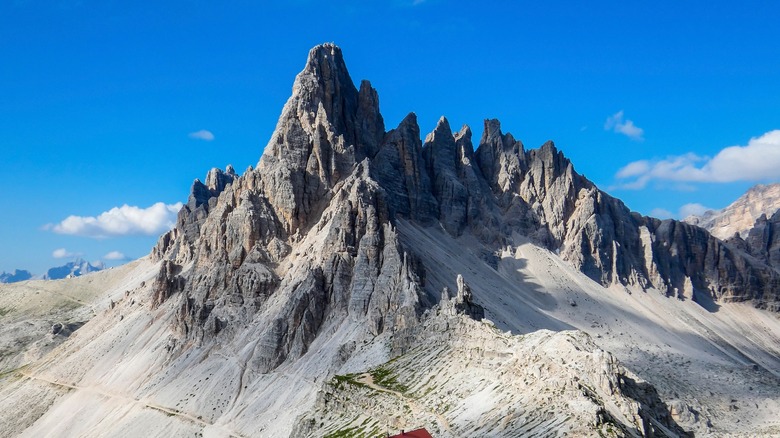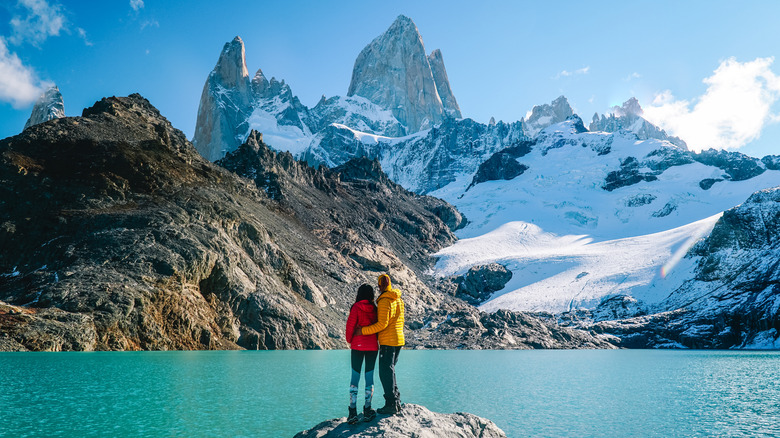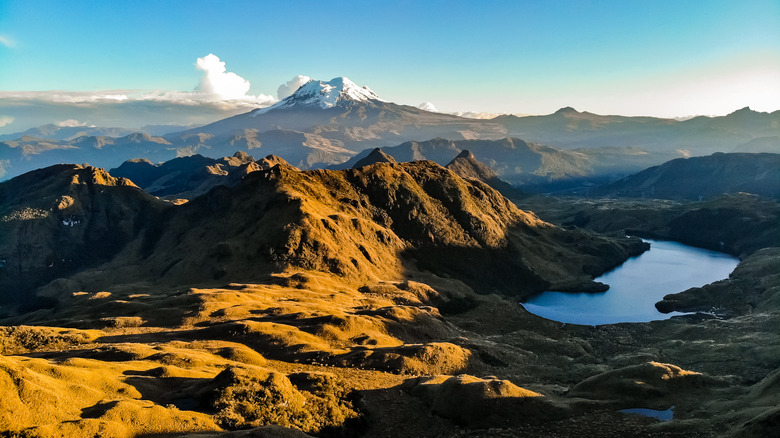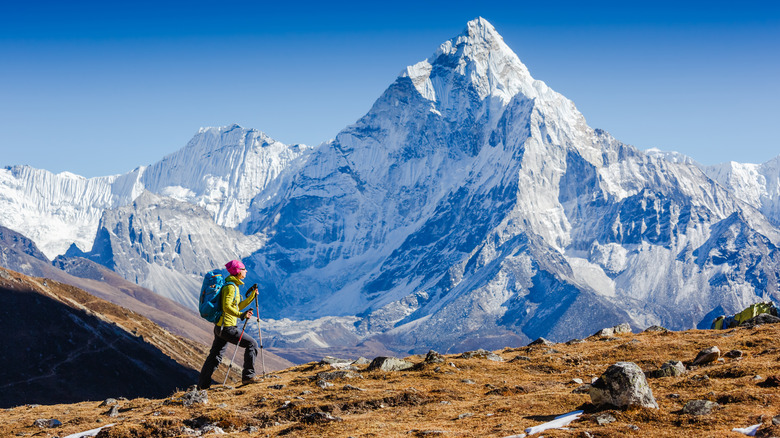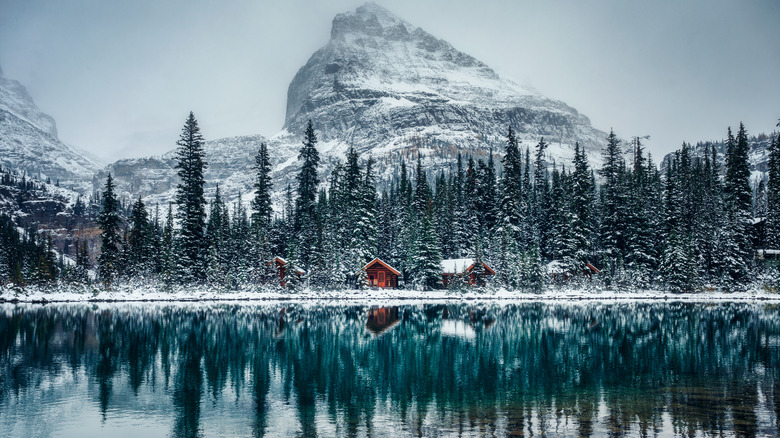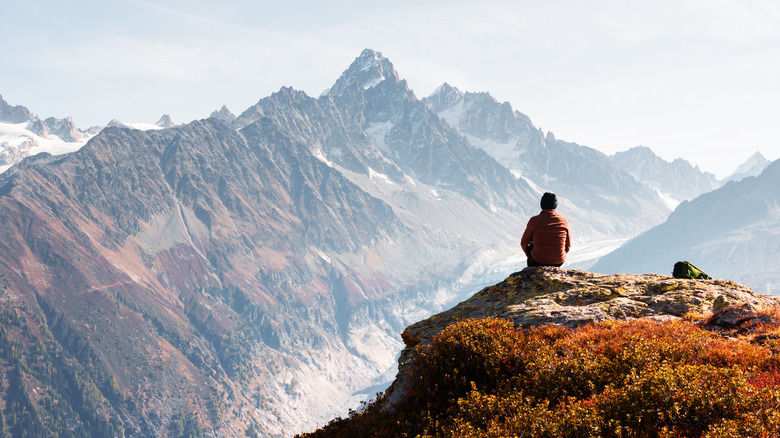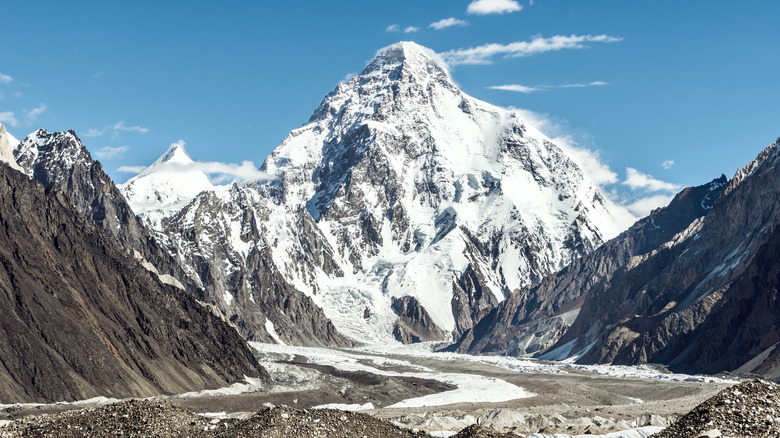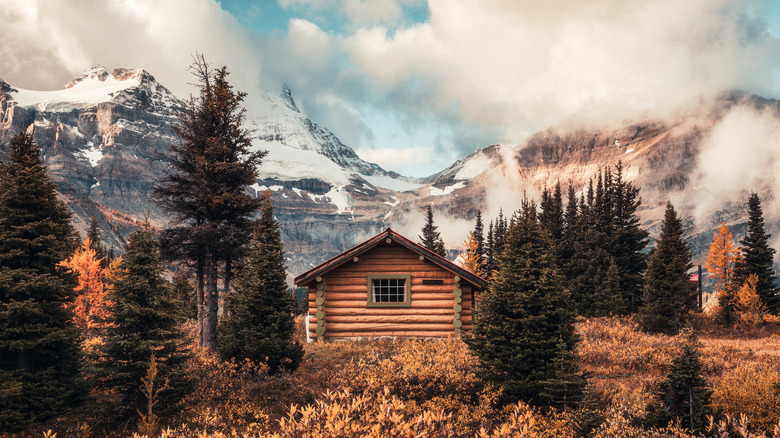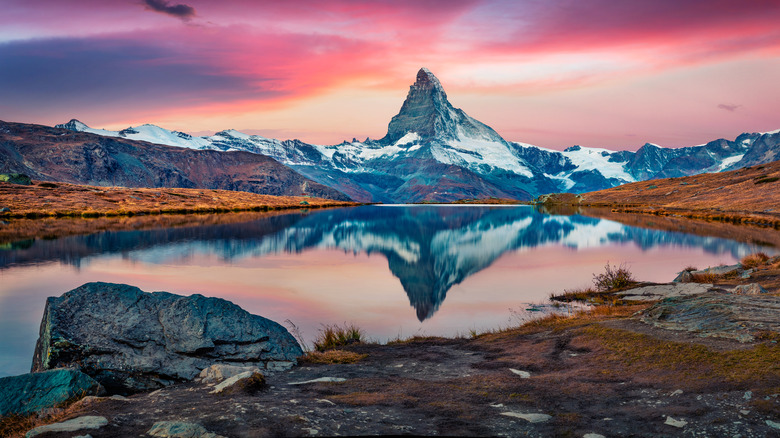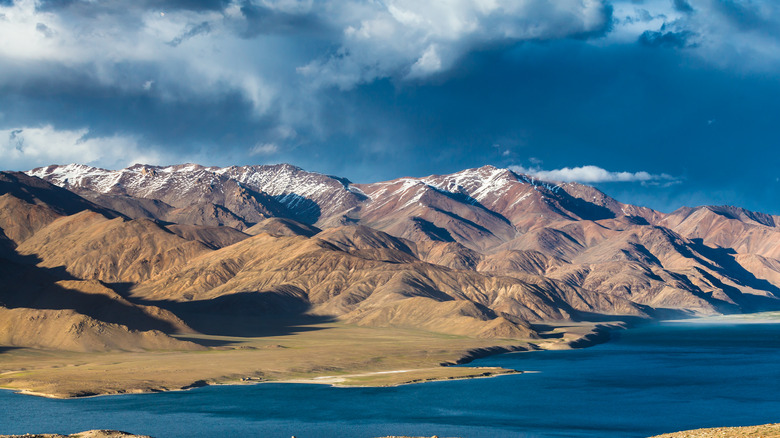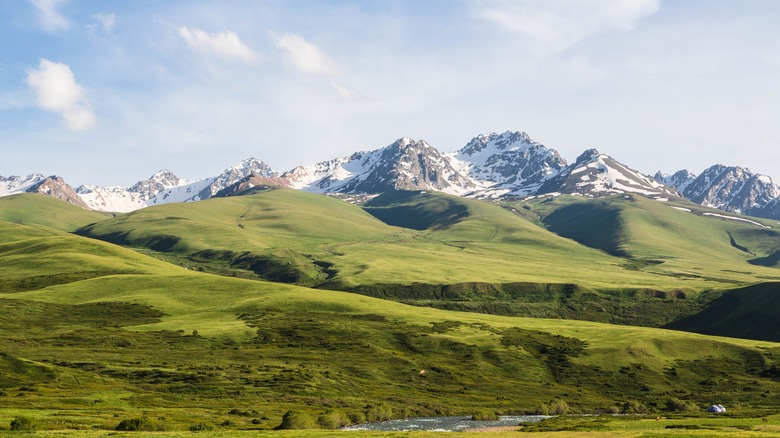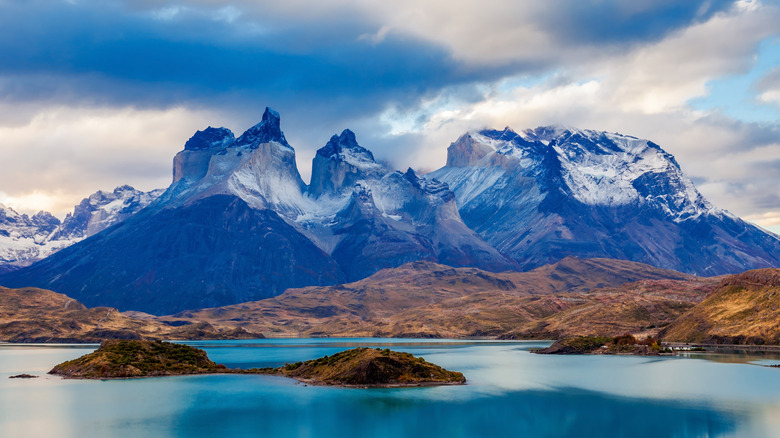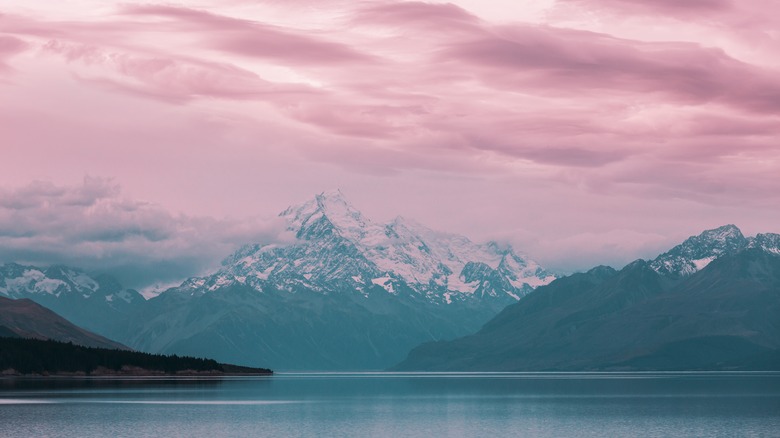The Best Time Of Year To Climb All Of The World's Greatest Mountains
Mountains are the ultimate escape for those with a nature-oriented personality and the world's greatest mountains make for a great trip! There's nothing better than hitting the trail, enjoying the amazing scenery, and letting your mind wander — whether that be for solving the world's problems or daydreaming. And luckily, mountain climbing is a hobby that can be done year-round if you know where to go and when. However, it's important to remember that no mountaintop is the same and you'll want to carefully consider the time of year when traveling for a climb. The peak of summer may seem like a good idea, that is until you arrive and realize hiking in 80-plus degrees isn't great. Likewise, the off-season can mean fewer people, but there are likely good reasons certain months are "off" for each mountain.
Additionally, don't try and tackle Everest during monsoon season and remember the seasons are reversed in the southern hemisphere. However, the world's greatest mountains are too numerous to count and exist on every continent, so choosing one to climb can prove difficult. Luckily, seasons can help narrow it down, as each peak has a different ideal time to be tackled. Below is a month-by-month breakdown to help you decide what mountain top or range is most appropriate for the time of year you plan to travel.
January
January is a great month for southern hemisphere peaks or those that are best hiked before the rainy season moves in. For example, Mount Aconcagua in Argentina earns the title of the tallest mountain in the world outside of Asia. It's also one of the "seven summits" — the tallest peak on each continent, beating out the rest of South America (per National Geographic). Aconcagua is also a wonderful mountain to attempt in January. Early summer in the Andes means perfect temperatures for an escape from winter in North America. Most people add Aconcagua to a visit to Mendoza. There are shorter one and three-day treks, but if you plan to summit the mountain, allow for about three weeks.
Alternatively, if you're looking for a different type of climate, Mount Kenya is also an excellent January option. The month is one of the driest in the area, making sure you won't slip or fall on slick mud or have to climb icy rocks. This season also ensures park camps and roads won't be washed out, which is a common problem when the rain arrives. Don't forget to check glacier cover, as it can fluctuate a lot from month to month and may impact your route.
February
Similar to the previous month, February is a month to tackle mountains below the equator or in hotter climates of the north. This time of the year is still generally dry in wetter climates and in South America, a nice time to climb mountains. In particular, Antisana is one of Ecuador's highest peaks, making for a great ascent in the second month of the year. The mountain is less-popular than other options in the country, despite the unmatched views and typically good conditions. This is likely due to the lack of camp or refuge available, so you'll need to bring your own supplies for nearly everything. It's very much a "fend-for-yourself" situation that also requires glacier skills. Thus, it's only advisable to attempt for the most experienced climbers or those with very good guides. But, if you do make the effort, you'll likely have amazing views mostly to yourself.
Additionally, if you fancy a different part of the world, this is also a great time to tackle the African continent's most famous peak — Mount Kilimanjaro. This is when the ideal conditions take place, per Climbing-Kilimanjaro, due to the good visibility and dry weather. However, it is high season so keep that in mind regarding crowds and pricing, although it is still more peaceful than peak summer months.
March
March warms up a bit, but you'll still want to stick to the southern hemisphere peaks while the north defrosts from the winter season. Down south, the peak summer heat has waned but precipitation has yet to come, making mountains like Ojos del Salado, which spans Chile and Argentina, a great option. As the tallest active volcano in the world, the highest peak in Chile, and the second tallest in South America, Ojos del Salada makes for an exciting adventure! However, never fear, it barely simmers anymore and just a bit of sulfuric smell is the only indication of its liveliness. According to Summit Post, which side and country you begin your climb depends on the type of experience you'd prefer. Chilean treks can be more relaxing, with pre-booked huts, jeep ride options, and the least strenuous hike up. On the other side, Argentina has lower fees and less bureaucracy around permits, but fewer amenities.
Mountains above the equator can be preferable this time of year due to the lack of rain and higher temperatures. If you prefer pre-monsoon climbs, this is when those start on the world's most famous mountain — Everest. Ian Taylor Trekking notes this is one of the best times to climb despite the frigid temps, as there are fewer crowds, and crisper views.
April
April is a wonderful month for mountaineering as the winter chill begins to recede in the northern hemisphere. Yet there is still some snow on the ground in many locations, making for nice winter adventures without freezing temps. The Canadian Rockies are prime for winter climbing during this period. Snow is still present enough for a nice ambiance with fewer layers required. But, four-wheel drive rental cars with snow tires are still a good idea, you may not even be allowed on certain roads without them! And remember to still practice avalanche safety!
Additionally, more pre-monsoon season Everest routes begin, but it's a bit warmer than the previous months. This can be preferable, but remember that nicer conditions can mean more people on the mountains and higher prices for amenities and supplies. Additionally, the warming temps do bring the chance of precipitation, monsoon rains won't occur but there is an increased chance of getting rained on. Even if that doesn't happen, views can be a bit less guaranteed than in winter months. Either way, it's nowhere near the level of the busy summer season, making April a nice time to climb Everest.
May
May is a fantastic month, as climbing options open up across the globe, but larges crowds have yet to descend. The Central European Alps (stretching from France to Italy to Slovenia) are a great range to tackle during this month. The days are longer and warmer but school holidays and long vacations haven't begun yet, meaning the mountains are much quieter. If you prefer a different kind of adventure, this is also a great time of year to head to the Atlas Mountains, just an hour and a half drive from Marrakesh. According to Audley Travel, Morocco's highest peaks have the most favorable conditions and nicest weather during the late spring to early summer months, as winter can see drastically low temperatures and treacherous trails and the heat of summer can be much too hot.
Across the Atlantic, back home in the U.S., the mountains of Washington state open for the season. The famous Cascade Range and Mount Rainier are prime for climbing thanks to nicer weather, and fewer people on the mountains. The snow is also receding, but still present enough for wonderful views. Finally, further south in Peru, this is the month the Inca Trail is best climbed, as major crowds arrive in June and July, per Intrepid Travel.
June
June ushers in the best summer climbing weather and the start of the high season across the globe. In the U.S., Alaska's Denali National Park is at its best at this time, according to Trip Savvy. Sure there will be more people, but it's also when conditions are best guaranteed to be favorable. Summers are beautiful in Alaska, with Denali's mountains turning green, and roads that are questionable in April and May becoming passable. Down south, the Bolivian Alps are at their most stable and comfortable conditions in June, per Bolivia Climbing Info.
Over in Asia, K2, the famous peak that spans China and Pakistan, opens for the season. Most climbs take place in July and August, per Summit Post, but June is the best option for those looking to avoid crowds without trading good conditions. Just note that K2 is famous for some not-so-nice reasons, it's a very technically challenging summit, and about one in four dies, per Summit Post. Finally, in Mongolia, the Tavan Bogd Mountains are at their best during this month, per Eternal Landscapes.
July
This month is truly high season in many mountain ranges and for good reason. Mid-Summer guarantees the best temperatures and conditions, most people are able to take time off, and amenities and services in mountain towns are in full swing. Mont Blanc in France, as well as the rest of the Alps from Italy to Switzerland to Bavaria, are at their best for mountaineering — without the obstacle of snow. The majority of the huts, transportation, and other services (including guided trips) are also in full swing, making July reliably good for climbing in Europe.
Additionally, the Canadian Rockies are fully accessible for climbing by July, with every campground, cabin, and trail open. You are also likely to see famous North American wildlife like bears and moose in the warmer season! Finally, if you are wishing for a South American adventure, Rough Guides recommends this time of year for the Peruvian Andes. This is due to cooler temps making climbs more comfortable and it's also the dry season — meaning more favorable conditions. Remember the fluctuation in day and night time temperatures though, which can be easy to forget in the summer! Be sure to pack accordingly.
August
The classic time of year for big trips, including a mountain climb, this is when some of the world's most famous mountains are truly at their best. According to Earth Trekkers, the well-known trio of Swiss peaks; Eiger, Mönch, and Jungfrau are best tackled in the summer. Additionally, the iconic Matterhorn is best climbed in August, per Alpine Guides, although as with any mountain, it's the luck of the draw when it comes to weather day-to-day. And of course, the best part of mountain climbing in Switzerland is the infrastructure and support. In most cases, you can take trains or gondolas to any trailhead and enjoy huts along the way!
Across the world in Asia, for those looking for a challenge lies excellent conditions for Cho Oyu in the heart of the Himalayas. Considered a "starter peak" for those looking to tackle the likes of Everest, per Mountain Madness, even the most experienced will want to climb in the best conditions, which take place in August. If you're not as confident in your skills, it might be a good idea to hire a guide and let the professionals guide you. Even if you consider yourself well-versed in the mountains, the Himalayas are another beast that can be safer with assistance.
September
Late summer into early fall can be a great time to climb mountains, particularly in Central Asia, which is beautiful this time of the year. Khan Tengri, which spans Kazakhstan and Kyrgyzstan, is a great option to climb at this tail-end of the northern climbing season. In fact, according to Trekking-Club, this is the month the mountain was first summited way back in 1931. So if you enjoy fall colors and crisp alpine air, it's definitely worth considering. Just remember the infrastructure is a bit sparse in this area, don't expect gondolas, huts, and other amenities on par with Switzerland, so definitely research and plan ahead!
Alternatively, the Pamir Mountains, which span Afghanistan, China, Uzbekistan, Kyrgyzstan, and Tajikistan are also in full fall bloom. September makes for the best month to try the Tajikistan entry to the range as the Pamir Highway is still and awash with foliage. This is also the last chance before the end of the year to enjoy the mountains sans snow, which is beautiful but makes climbs a bit more difficult.
October
October is a quieter month for climbing, as it's cooled off and may have started to snow in the northern hemisphere. Meanwhile, places south of the equator are still waiting for summer to arrive and may be awaiting the rainy season. However, if you still desire a trek or perhaps this is the only time of year you could get vacation time, head to Kyrgyzstan, and climb Tian Shan. Central Asia is awash in the most beautiful fall colors you could ever imagine during this time period and the crisp autumn air is perfect for days spent in the mountains.
According to Much Better Adventures, distances should not be underestimated in Tian Shan. Due to the exceptional altitude, even the shortest climbs and treks can take a lot out of you. The weather is also extremely unpredictable, no matter the season, so it's advised to bring a variety of clothing and supplies. Additionally, like many of the more remote and difficult climbs on this list, depending on your skill and comfort level, a guide or local assistance may be a good idea. No matter how many mountains you climb, caution never hurt!
November
November halts most mountaineering in the northern hemisphere, and ushers in the wonderfully warm season in South America. Particularly the famously mountain-heavy giants, Argentina and Chile. This is a fantastic time to head to Patagonia, in many places the snow is still melting off, making it a picturesque environment to explore. Just keep in mind this is also when the busy season starts, so plan to visit popular places earlier or later in the day. However, this is the best time of year to tackle giants like Mount Fitz Roy, Cerro Torre, Cordillera Paine, and Torres del Paine, per Best Time 2 Travel and Marchay.
If Patagonia is a bit too far or intimidating, Mexico has Pico de Orizaba. Its highest peak is near enough to Puebla that you can enjoy the famous cuisine easily after conquering the mountain! Additionally, the country is home to Iztaccihuatl between Mexico City and Puebla. Both volcanoes are great options during this season. November is also the pre-high season in Mexico since it's before the holidays and winter, so you'll enjoy fewer people on your trip!
December
The last month of the year is another one where south-of-the-equator destinations shine. New Zealand is wonderful this time of the year and not as hot — or full of deadly creepy crawlies like its neighbor, Australia. Aotearoa is also a mountain-lovers paradise, with Mount Cook and the Southern Alps as well as Mount Tasman and the Central Otago. Then relax on one of New Zealand's numerous beaches, from oceanside to lakes, the sparsely populated country is full of sandy shores waiting to be discovered. Another great part about climbing in New Zealand is that it's easy and safe to do many on your own — with plenty of huts and help available.
If a 15-plus hour flight (depending on where you fly from) is a bit too much to stomach, December is lovely in Colombia. Even better, the Cordillera Central makes for a great adventure climb. The highest points of the Colombian Andes are lush with greenery and mostly snow-free during this time. And just like in New Zealand, you can easily cool off at a beach post-climb! No matter which of these great mountains of the world you choose, I can't think of a better ending to a year!
